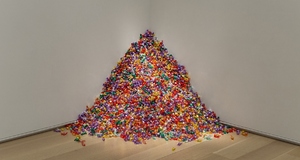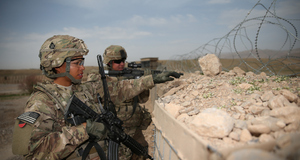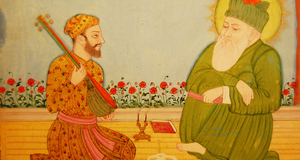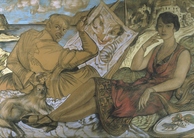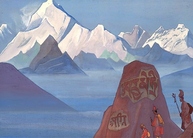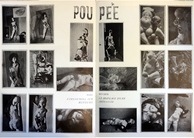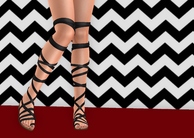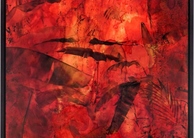The Visual Vocabulary of Chitra Ganesh: Femininity, Sexuality, and Abjection in Ganesh's Visual Art
By
2013, Vol. 5 No. 10 | pg. 1/2 | »
KEYWORDS:
Whence does the definitive understanding of the human body as a site of power, pleasure, and horror come? Is there at all a definitive notion of the extent of the body’s capabilities in the first place? The body, long established as an inspirational source for higher form and interpretation throughout the canon of art history, has become a source of contention within the realm of contemporary art. Though the body was previously the most immediate foundation for figurative art, it became more of a tool for manipulation and experimentation beginning with twentieth century modernism and this experimentation has been taken to new levels and interpreted in innumerable ways by contemporary artists in an international forum. Indian-American artist Chitra Ganesh, through manipulation of various media and interpolation of queer and feminist subjectivities into recognizable traditional imagery, takes up the challenge of re-presenting the female body to elicit a more nuanced understanding of self, subjectivity, and sexuality. Her body of work, ranging from traditional media such as painting and more currently employing digital graphics and installation, is multivalent and addresses themes of diasporic identity, femininity, religious imagery and mass popular culture of India and can be viewed through several critical lenses. This critical reading of her oeuvre will posit that the theme of abjection as put forth by Julia Kristeva runs through the various iterations of form and body and lends itself well to feminist critique. Like many other contemporary artists, and similar to many contemporary Asian American artists, Chitra Ganesh operates through a politics of subversion, using strategies that either directly or indirectly question the validity of existent norms and myths of culture. The effectiveness of Ganesh’s subversive art, however, is derived from her appropriation of popular culture and mass media from her Indian heritage. This achieves a basic familiarity from her Indian (and Indian American audience); however, those who do not immediately recognize the tropes that Ganesh has reinterpreted and appropriated can understand the extreme divergence that Ganesh makes because Ganesh favors gross imagery and disfiguration as a form of social critique. The efficacy of Ganesh’s strategy is twofold. First, by incorporating images with which she is familiar, Ganesh can move beyond investigating why a hegemonic narrative is constructed and move directly to how this narrative has been effective in shaping Indian and Indian American identity. Her most direct engagement with the dissemination of hegemonic narratives in visual culture is the genre of Indian popular comics Amar Chitra Katha, a series of comic strips that have been used to teach Hindu mythology to Indian and children of the Indian diaspora since the 1960s.1Ganesh, in realizing the extent of Amar Chitra Katha’s popularity and the dynamic role that it played in shaping her own identity, moves on to question the intent and effect of imposing a Hindu sense of nationalism via popular media that directly engages children, who are easily susceptible to propaganda. Since the comic series has extended beyond the subcontinent to American born Indians such as Ganesh, it invokes “diasporic memory,” a collective (and often unlived or not experienced) memory that traverses borders to “excavate the past not as the locus of originary culture or identity but as a site of unpredictable desires and embodiments.”2 By utilizing this source, Ganesh can investigate the underpinnings of what exactly can constitute a “collective memory” and how this sort of propagandistic ploy can shape a psychological understanding of identity as constituted by a shared visual culture.Secondly, examining and utilizing popular Hindu mythological culture that has been embedded into the minds of a shared “Indian” experience allows Ganesh room to explore overlooked and marginal characters. She states that using the comic and zine culture allows her a “familiar point of entry into a disjunctive tale that privileges the dissonance between text and icon, rather than a unity of illustration and text” so that she can pull apart myth and narrative “to retrieve critical moments of abjection, desire, and loss.”3 By focusing on marginal figures that have been overlooked, Ganesh imposes her own subjective experiences and desires onto an already existing hegemonic narrative; this serves as her form of critique but also establishes the possibility of dismantling the dominance of myth and interpolating feminism and abjection into the body of work. Abjection as defined by Julia Kristeva is the notion of rejecting the I as previously established in Freudian and Lacanian psychoanalysis. It is the “jettisoned object, is radically excluded and draws me toward the place where meaning collapses.”4 Abjection is experienced when one encounters experiences of filth and defilement such as excrement, vomit, blood and decay that reminds one of one’s own humanity. For Kristeva, the abject is inherently connected to language and is of the semiotic, pre-linguistic order attached to maternity. In opposition to the Freudian position that the Self is constructed through the Oedipal rejection of the paternal prohibition, Kristeva says that the subject becomes independent and defines him/herself by rejecting those attributes (the improper, unclean fluidity experienced in the womb) that connect the subject to the mother.5 Thus expressed, abjection is a process by which identity is constituted and socialized through normative behavior; in order to function within society, a subject must reject filth and the abject to become incorporated into the Real. However, exposure to the abject is simultaneously a putative realization of the Self; it is through the occurrence of the abject and the subsequent response that filth elicits that the Self is truly aware of the limitations of mortality. Visual analysis of Chitra Ganesh’s digital print River of Sorrow (2006) (Fig. 1) is exemplary of the integration of comic culture and the visual lexicon of Amar Chitra Katha as a means to express the notion of abjection. The digital imagery is a direct reference to the typology of women as goddesses and chaste virtuous women who retain their moral integrity in the face of adversity. However, Chitra Ganesh interrupts this moralistic undertone with fantasy elements of her own and uses her own text in the speech bubbles to express, in cryptic terms, the nature of femininity as a construct imposed by dominant hegemonic forces. The integration of text is an expressive and direct means by which meaning can be employed but these textual interpolations do not directly interpret the images. The texts “map out an alternative geography where queer, female, brown bodies refuse to stay in place. The queerness of Ganesh’s work resides partly in her refusal to render the work’s meaning immediately intelligible.”6 Figure 1: Chitra Ganesh, River of Sorrow, 2006. Digital Print, 28 x 20 inches. 
If queerness figures into the abstraction of meaning through text, then it is through images that abjection can be directly understood. In River of Sorrow, the female protagonist lies on her side. She is a fantastic amalgamation of mortal and goddess as her otherwise human body is given multiple arms reminiscent of deities such as Kali and Durga. From the gaping gash in the protagonist’s chest emerges a transcendent figure of wisdom and spirituality that implores the protagonist (and by extension, the viewer) to consider the case of Pandora, the mythological figure who released evil into the mortal world. The gash is a direct source of abjection, for its presence not only rips the flesh and exposes blood and mortality, but rips through the psyche as well, forcing the viewer to consider the source of higher thinking or wisdom as emerging from within oneself. It is necessary for Ganesh, however, to explicitly place this source outside of the body to expose the conception of how the Self is realized through the external foundations of abjection. The skulls upon which the protagonist rests her head further substantiate the imminence of death and the very loss of the Self. Kristeva views the corpse, the dead body as the ultimate form of abjection for it is “death infecting life…It is something from which one does not part, from which one does not protect oneself as from an object,” as it poses a “real threat…and ends up engulfing us.”7Continued on Next Page » Suggested Reading from Inquiries Journal
Inquiries Journal provides undergraduate and graduate students around the world a platform for the wide dissemination of academic work over a range of core disciplines. Representing the work of students from hundreds of institutions around the globe, Inquiries Journal's large database of academic articles is completely free. Learn more | Blog | Submit Latest in Visual Arts |







